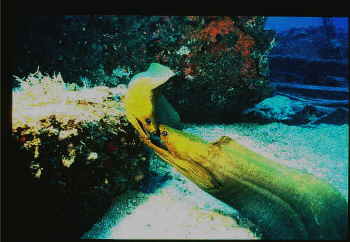
- Other Issues
- >> The Gulfstream Issue
- >> Why South Florida diving is so spectacular
About the South Florida Dive Journal, and what's so special about South Florida Diving Dive Journal
©Cybergate, Inc. 1994 All Rights Reserved
|
Contributing Photo Journalists and writers include:
|
The Gulf Stream
On land we have the biblical garden of Eden, where all life originated; in the ocean we have the Gulf Stream. Within the Gulf Stream, life is created, it blossoms, and a million worlds exist as rich homes for a Quadrillion more forms of life. Throughout the vast expanse covered by this river of global proportions, most divers have no opportunity to experience its many secrets or great beauties; its course is too far from land to be accessible to most of the world, and its deep blue depths far beyond the technological intrusions of mankind.
This great body of water moves ever northward from Equatorial origins, traversing the world to as far as the Arctic Circle. In this entire range only one dive resort destination has any real access to it. In all the world, only off the coast of South Florida does the Gulf Stream actually flow over shallow coastal reefs.
 For a brief 100 miles of Coastline, the Gulf Stream turns inward toward land, frequently coming to within 1/4 mile from shore along the reef lines, sometimes even intruding into inlets. To divers this allows diving unlike any Caribbean, Keys or other exotic destination. It allows a unique blend of excellent visibility, beautiful live corals, and a rich life source of marine estuaries along the Palm Beach coastline. If this nutrification occurred along a Keys or Cayman type reef environment, the corals would all be killed by an oversupply of nutrient. In Palm Beach, the Gulf Steam constantly cleanses the coral reefs, and the inshore mixing zone provides a feeding ground for one of the worlds richest breeding grounds for marine life. While Palm Beach reefs reefs are known for their large schools of fish |
 |
a large part of this dynamic ecosystem is derived from tiny forms of life many divers never notice. It's really not that hard to find the larger members of this "macro world" like the Squat Anmone Shrimp, where your first step is just looking for the much larger Sea Anemone it lives in. |
 |
Divers actually see many other members of this same macro world, often without even realizing it. One frequent example occurs when a diver in Palm Beach sees a cloud of what looks very much like mosquitoes, usually swarming around a ledge crevice or overhang. |
 |
If you were to get closer, and magnify these tiny creatures with a powerful macro lens, you'd see a tiny form of shrimp very important to the health of reef systems. |
 |
If you had this very powerful magnification, you would also see this similar species of shrimp shrimp sitting on a spicule (pore) of a sponge. |
 |
[TOC]
DRIFT DIVING VS ANCHOR DIVING....NO CONTEST!
Drift Diving, Palm Beach style, is easier. Drift Diving lets you cover miles of reef instead of yards of reef. |
Drift Diving is like having your own dive scooter, except you don't have to carry it out of the water with you when you get back on the boat. Drift Diving also MEANS you don't have to expend energy swimming back to the boat at the end of the dive...the boat follows your float-ball (towed on a light line by you, someone in your group, or the divemaster). When you surface, the boat comes to you! And drift diving is just alot more fun than anchor diving. |
How Palm Beach Drift Diving is Different
Palm Beach's greatest asset is the Gulf Stream. In addition to bringing Palm Beach spectacular visibility year round, this enormous "river" of water also serves as the largest migratory corridor for fish in this Hemisphere. Divers experience this constantly replenishing life source as an undreamed of underwater wilderness. As they drift effortlessly over mile after mile of spectacular live coral reef, huge cliff-like ledges, and continuous clouds of fish, the sensory overload experienced changes these divers forever. If they ever travel to Cayman again, the feeling of a quiet, sterile and lifeless surrounding begins to intrude into their appreciation of what used to be spectacle. The beauty of Grand Cayman becomes that of a botanical garden, the spectacle of Palm Beach that of the pure wilderness of Yosemite National Park. [TOC] [NEXT ARTICLE: Breakers Reef...an easy, relaxing dive for novices or intermediates] [TOC] |
